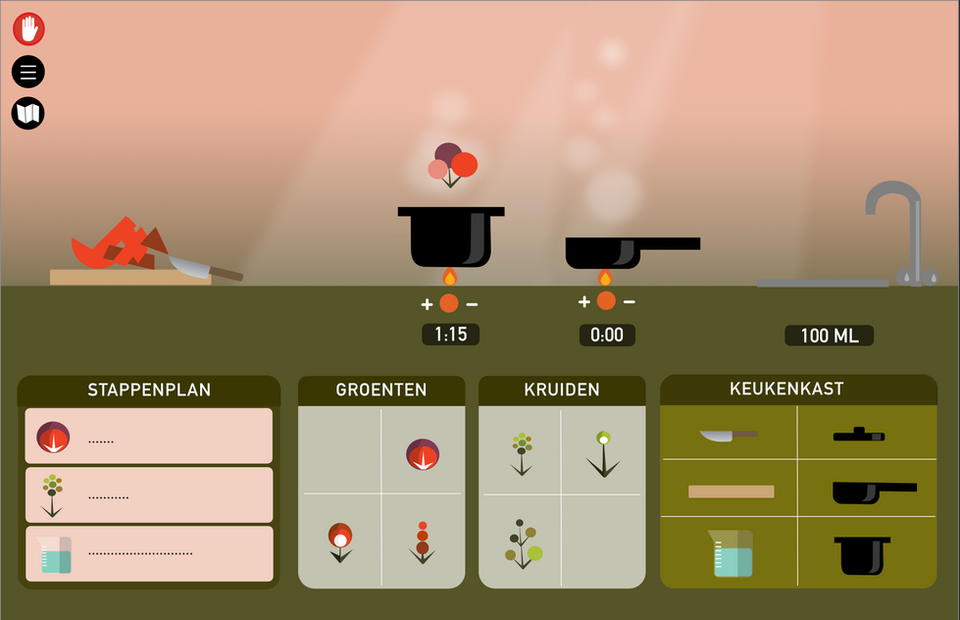


PLAN
EXECUTIVE FUNCTIONS
Executive functions refer to multidimensional (higher-order) cognitive functions involved in control and direction of purposeful behaviour, including planning, initiation, and attention regulation, and being essential for independent, socially useful, and constructive activities. Impairments of executive functions comprise a person’s capacity to maintain effective and independent functioning in daily life, especially in novel, complex or demanding situations.
Learning a strategy to subdivide a daily task into multiple steps
To improve the execution of complex everyday activities
GMT THERAPY
Motivational and interactive addition to the conventional treatment
To practice the GMT strategy in different executive demanding situations and tasks
PLAN GAME
Tool to support in the execution of everyday activities
All the components of GMT are included
PLAN APP
GOAL MANAGEMENT TRAINING (GMT)
A well-known and extensively studied treatment for executive dysfunction is Goal Management Training (GMT). GMT is developed by Ian Robertson in the mid-1990s, and is based on the notion that executive dysfunction is associated with goal neglect. Goal neglect is defined as disregard of a task requirement even though it has been understood and remembered, and leads to problems with goal-directed behaviour which is required for executive control during everyday task performance. To handle these executive difficulties of planning and goal-directed behaviour, GMT entails learning and applying a compensatory strategy in which a daily task is subdivided into multiple steps. The steps are as follows: (1) stop and ask, ‘what am I doing?’; (2) define the main task; (3) list the steps; (4) learn the steps; (5) do them; and (6) check, ‘am I doing what I planned?’. In summary, the main objectives of GMT are to train individuals to periodically stop ongoing behaviour, to interrupt automatic processing, bring their overall goal to mind, subdivide the overall goal into steps, and monitor performance as they proceed.

EVIDENCE OF GMT
Several studies have demonstrated that GMT is a successful treatment for executive dysfunction in brain injured individuals. In 2000, Levine et al. provided both experimental and clinical support for the efficacy of GMT in two studies. In a randomized group trial and in a case study, the validity of GMT was assessed and found to improve performance on both paper and pencil everyday tasks, and also on meal preparation, a real-life instrumental activity of daily living task. In addition, several other studies have supported these findings. For example, Van Hooren et al. (2007) examined the contribution of GMT in elderly persons with executive problems, Spikman et al. (2010) and Bertens et al. (2015) evaluated the effects of GMT in combination with other cognitive rehabilitation methods in individuals with ABI, and Grand, Ponsford and Bennett (2012) investigated the efficacy of the treatment on day to day financial management. So, all randomized controlled trials (RCTs) concluded that GMT results in improvements concerning executive functioning in daily life. To conclude, a recent meta-analysis by Stamenova and Levine (2018) also revealed sufficient evidence for the effectiveness of GMT after brain injury, that was usually maintained at follow-up.









KL PLAN GAME
As an extension to the conventional GMT therapy, we have developed a serious game that includes the key concepts of GMT. KL Plan is the first serious game based on a cognitive strategy training (part of the compensatory approach) for patients with executive dysfunction. The game is designed to train GMT strategy use by providing multiple executive function exercises, such as planning a route, collecting rocket components or organizing ingredients based on a recipe.
KL PLAN APP
Next to the KL Plan training-game, we also developed an app Karman Line PLAN, which is a mobile application that can be used as an aid during the performance of everyday activities. We developed the tool to ensure that patients regain control over their task execution and are able to perform everyday activities independently. The tool is a digital translation of the GMT strategy, so all the components of GMT are included. Important to notice is that individuals are able to list the steps by writing down the steps as well as by uploading photos. In addition, patients are able to share activities with their family members or with their therapist to optimize the listed steps, and all the activities are saved automatically. So, once an activity is filled in correctly, an individual can directly start the tool to support in the execution of the task.

GMT IN CLINICAL PRACTICE
The game and tool are a motivational and interactive addition to the treatment but does not serve as a substitute for the role of the therapist or for the treatment itself. The GMT treatment is administered by a trained neuropsychologist in consultation with a cognitive trainer or occupational therapist. The therapy is structured into seven sessions, with patient-specific activity related goals, information about executive dysfunction to raise awareness, explanations on goal management, and homework assignments (e.g. aimed at filling in the treatment goals in the app and playing the game to facilitate transfer to daily life). The sessions are administered once a week for 60 minutes at each attendance. The therapy includes a comprehensive manual for the therapist, the KL Plan game, KL Plan tool, and all the necessary (other) components to implement the GMT therapy.














